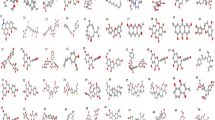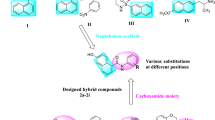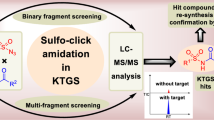Abstract
A series of novel pyridazine-acetohydrazide hybrids were designed, synthesized, and evaluated for their in vitro and in vivo antihyperglycemic activity. In this context, pyridazine-acetohydrazides (6a–6p) were synthesized by coupling substituted aldehyde with 2-(5-cyano-6-oxo-3,4-diphenylpyridazine-1-6H-yl) acetohydrazide, which was prepared via the reaction of pyridazine ester with hydrazine hydrate. The molecular docking study was carried out to examine the binding affinities and interaction of designed compounds against the DPP-4 enzyme. Compounds 6e, 6f, 6l, and 6n exhibited interaction with active residue. In silico ADMET properties, and toxicity studies corroborated that compounds were found to have good bioavailability and less toxic. The synthesized compounds were further estimated for in vitro DPP-4 activity. Compounds 6e and 6l were found as the most effective DPP-4 inhibitor in this series with IC50 values (6.48, 8.22 nM) when compared with sitagliptin (13.02 nM). According to the toxicity assay compound, 6l showed very less toxicity at a higher concentration so further selected for the in vivo antihyperglycemic activity.
Graphical abstract













Similar content being viewed by others
References
American Diabetes Association (2004) Diagnosis and classification of diabetes mellitus. Diabetes Care 27:5–10. https://doi.org/10.2337/diacare.27.2007.S5
American Diabetes A (2009) Diagnosis, and classification of diabetes mellitus. Diabetes Care 32:62–67. https://doi.org/10.2337/dc09-S062
Reusch JE, Manson JE (2017) Management of type 2 diabetes in 2017: getting to goal. JAMA 317:1015–1016. https://doi.org/10.1001/jama.2017.0241
Sebokova E, Christ AD, Boehringer M, Mizrahi J (2007) Dipeptidyl peptidase IV inhibitors: the next generation of new promising therapies for the management of type 2 diabetes. Curr Top Med Chem 7:547–555. https://doi.org/10.2174/156802607780091019
Arun C, Chitharanjan D, Sena RDV, Shashank K, Aditya C, Rahul R, Asween M, Nawal Singh S (2017) Clinical Review of antidiabetic drugs: implications for type 2 diabetes mellitus management. Front Endocrinol 8:6. https://doi.org/10.3389/fendo.2017.00006
Monika G, Sarbjot S, Pun G (2009) Dipeptidyl Peptidase-4 Inhibitors: a new approach in diabetes treatment. Int J Drug Dev & Res 1(1):146–156
Dallumal RM, Chua SS, Wu DB-C, Vethakkan SR (2015) Sitagliptin: is it effective in routine clinical practice. Int J Endocrinol 2015:950571. https://doi.org/10.1155/2015/950571
White JR (2011) Alogliptin for the treatment of type 2 diabetes. Drugs Today 47(2):99–107. https://doi.org/10.1358/dot.2011.47.2.1583163
McKeage K (2015) Trelagliptin: first global approval. Drugs 75:1161–1164. https://doi.org/10.1007/s40265-015-0431-9
Zhong J, Gong Q, Goud A, Srinivasamaharaj S, Rajagopalan S (2015) Recent advances in dipeptidyl-peptidase-4 inhibition therapy: lessons from the bench and Clinical Trials. J Diabetes Res 14:606031. https://doi.org/10.1155/2015/606031
Rai SK, Khanam S, Khanna RS, Tewari AK (2014) Cascade synthesis of 2-pyridones using acrylamides and ketones. RSC Adv 4:44141–44145. https://doi.org/10.1039/c4ra06619g
Rai SK, Singh P, Kumar R, Tewari AK, Hostaš J, Gnanasekaran R, Hobza P (2016) Experimental and theoretical study for the assessment of the conformational stability of polymethylene-bridged heteroaromatic dimers: a case of unprecedented folding. Cryst Growth Des 16(3):1176–1180. https://doi.org/10.1021/acs.cgd.5b01807
Radwan MAA, Alshubramy MA, Abdel-Motaal M, Hemdan BA, El-Kady DS (2020) Synthesis, molecular docking and antimicrobial activity of new fused pyrimidine and pyridine derivatives. Bioorg Chem 96:103516. https://doi.org/10.1016/j.bioorg.2019.103516
Elmeligie S, Ahmed EM, Abuel-Maaty SM, Zaitone S-B, Mikhail DS (2017) Design and synthesis of pyridazine containing compounds with promising anticancer activity. Chem Pharm Bull 65(3):236–247. https://doi.org/10.1248/cpb.c16-00532
El-Ansary AK, Kamal AM, Al-Ghorafi MA (2013) Design, and synthesis of some thieno[2,3-c] pyridazine derivatives of expected anticancer activity. Med Chem Res 22:2589–2601. https://doi.org/10.1007/s00044-012-0258-9
Loksha YM, Abd-Alhasee MM (2020) Synthesis and biological screening of some novel 6-substituted 2-alkylpyridazin-3(2H)-ones as anti-inflammatory and analgesic agents. Arch Pharm Chem Life Sci. https://doi.org/10.1002/ardp.201900295
Farghaly AM, AboulWafa OM, Elshaier YAM, Badawi WA, Haridy HH, Mubarak HAE (2019) Design, synthesis, and antihypertensive activity of new pyrimidine derivatives endowing new pharmacophores. Med Chem Res 28(3):360–379. https://doi.org/10.1007/s00044-019-02289-6
Dong ZQ, Liu XM, Wei CX, Quan ZS (2015) Design, synthesis of 6-substituted-pyrido[3,2-d] pyridazine derivatives with anticonvulsant activity. Med Chem 11(6):595–601. https://doi.org/10.2174/1573406411666150313152925
Singh B, Bhatia R, Pani B, Gupta D (2020) Synthesis, crystal structures and biological evaluation of new pyridazine derivatives. J Mol Struct 1200:127084. https://doi.org/10.1016/j.molstruc.2019.127084
Zaoui Y, Ramli Y, Tan SL, Tiekink ERT, Chemlal L, Mague JT, Jamal Taoufik ME, Faouzi A, Ansar M (2021) Synthesis, structural characterization and theoretical studies of a novel pyridazine derivative: Investigations of anti-inflammatory activity and inhibition of α-glucosidase. J Mol Struct 1234:130177. https://doi.org/10.1016/j.molstruc.2021.130177
Deeb A, El-Eraky WI, El-Awdan SA, Mahgoub S (2013) Pyridazine and its related compounds. Part 34. Hypoglycemic and hypolipidemic activity of some novel condensed pyridazine sulfonamides. Med Chem Res 23:34–41
Adib M, Peytam F, Rahmanian-Jazi M, Mohammadi-Khanaposhtani M, Mahernia S, Bijanzadeh HR, Jahani M, Imanparast S, Faramarzi MA, Mahdavi M, Larijani B (2018) Design, synthesis and in vitro α-glucosidase inhibition of novel coumarin-pyridines as potent antidiabetic agents. New J Chem 42:17268–17278. https://doi.org/10.1039/C8NJ02495B
Tsuji T, Yamaguchi M, Kuroyanagi J, Furuzono S, Konishi M, Terayama K, Tanaka J, Saito M, Kobayashi Y (2019) Discovery of novel pyridazine derivatives as glucose transporter type 4 (GLUT4) translocation activators. Bioorg Med Chem Lett 29(14):1785–1790. https://doi.org/10.1016/j.bmcl.2019.05.013
Moghimi S, Toolabi M, Salarinejad S, Firoozpour L, Ebrahimi SES, Safari F, Mojtabavi S, Faramarzi MA, Foroumadi A (2020) Design and synthesis of novel pyridazine N-aryl acetamides: in-vitro evaluation of α-glucosidase inhibition, docking, and kinetic studies. Bioorg Chem 102:104071. https://doi.org/10.1016/j.bioorg.2020.104071
Adib M, Peytam F, Rahmanian-Jazi M, Mohammadi-Khanaposhtani M, Mahernia S (2018) Design, synthesis and in vitro α-glucosidase inhibition of novel coumarin-pyridines as potent antidiabetic agents. New J Chem 42:17268–17278. https://doi.org/10.1039/C8NJ02495B
Bindu B, Vijayalakshmi S, Manikandan A (2020) Synthesis and discovery of triazolo-pyridazine-6-yl-substituted piperazines as effective anti-diabetic drugs; evaluated over dipeptidyl peptidase-4 inhibition mechanism and insulinotropic activities. Eur J Med Chem 187:111912. https://doi.org/10.1016/j.ejmech.2019.111912
Rai SK, Khanam S, Khanna RS, Tewari AK (2015) Design and synthesis of 2-pyridone based flexible dimers and their conformational study through X-ray diffraction and density functional theory: perspective of cyclooxygenase-2 inhibition. Cryst Growth Des 15(3):1430–1439. https://doi.org/10.1021/cg501793v
Kumar R, Gaurav A, Pal S, Kumar K, Sridhar B, Tewari A (2017) Reverse intramolecular stacking in o-xylene bridge symmetrical dimers of 2-thiopyridine derivative: assessment of the conformational stability. Chemistry Select 2:3249–3255. https://doi.org/10.1002/slct.201700269
Dubey R, Singh P, Singh AK, Yadav MK, Swati D, Vinayak M, Puerta C, Valerga P, Ravi Kumar K, Sridhar B, Tewari AK (2014) Polymorphic signature of the anti-inflammatory activity of 2,2′-{[1,2-phenylenebis(methylene)]bis(sulfanediyl)}bis(4,6-dimethylnicotinonitrile). Cryst Growth Des 14(3):1347–1356. https://doi.org/10.1021/cg401842y
Rai SK, Singh P, Khanam S, Tewari AK (2016) Polymorphic study and anti-inflammatory activity of a 3-cyano-2-pyridone based flexible model. New J Chem 40:5577–5587. https://doi.org/10.1039/C5NJ03683F
Kumar R, Singh P, Gaurav A, Yadav P, Khanna RS, Tewari AK (2016) Synthesis of diphenyl pyridazinone-based flexible system for conformational studies through weak noncovalent interactions: application in DNA binding. J Chem Sci 128(4):555–564. https://doi.org/10.1007/s12039-016-1059-3
Shi X, Gu A, Ji G, Li Y, Di J, Jin J, Wang X (2011) Developmental toxicity of cypermethrin in embryo-larval stages of zebrafish. Chemosphere 85(6):1010–1016. https://doi.org/10.1016/j.chemosphere.2011.07.024
Zhou S, Dong Q, Li S, Guo J, Wang X, Zhu G (2009) Developmental toxicity of cartapon zebrafish embryos. Aquat Toxicol 95:339–346. https://doi.org/10.1016/j.aquatox.10.006
Scholz S, Fischer S, Gundel U, Kuster E, Luckenbach T, Voelker D (2008) The zebrafish embryo model in environmental risk assessment applications beyond acute toxicity testing. Environ Sci Pollut Res Int 15:394–404. https://doi.org/10.1007/s11356-008-0018-z
Singh P, Kumar R, Yadav B, Khanna R, Tewari A (2014) CCSO nano catalyzed solid-phase synthesis of 3-oxo-5,6-disubstituted-2,3-dihydropyridazine-4-carbonitrile. RSC Adv 4:51239–51243. https://doi.org/10.1039/C4RA06640E
El-Dean AMK, Geies AA, Radwan SM (1999) Studies of pyridazine derivatives: synthesis of pyrrolo[2,3-c]pyridazine and related compounds. Bull Polish Acad Sci Chem 47(2):135–142
Lakshmithendral K, Saravanan K, Elancheran R, Archana K, Manikandan N, Arjun HA, Ramanathan M, Lokanath NK, Kabilan S (2019) Design, synthesis and biological evaluation of 2-(phenoxymethyl)-5-phenyl-1,3,4-oxadiazole derivatives as anti-breast cancer agents. Eur J Med Chem 168:1–10. https://doi.org/10.1016/j.ejmech.2019.02.033
Li N, Wang L-J, Jiang Bo, Guo S-J, Li X-Q, Chen X-C, Luo J, Li C, Wang Yi, Shi D-Y (2018) Design, synthesis and biological evaluation of novel pyrimidinedione derivatives as DPP-4 inhibitors. Bioorg Med Chem Lett 28(12):2131–2135. https://doi.org/10.1016/j.bmcl.2018.05.022
Patel BD, Bhadada SV, Ghate MD (2017) Design, synthesis and anti-diabetic activity of triazolotriazine derivatives as dipeptidyl peptidase-4 inhibitors. Bioorg Chem 72:345–358. https://doi.org/10.1016/j.bioorg.2017.03.004
Bindu B, Vijayalakshmi S, Manikandan A (2020) Synthesis and discovery of triazolo-pyridazine-6-yl-substituted piperazines as effective anti-diabetic drugs; evaluated over dipeptidyl peptidase-4 inhibition mechanism and insulinotropic activities. Eur J Med Chem 187(1):111912. https://doi.org/10.1016/j.ejmech.2019.111912
Banerjee P, Eckert AO, Schrey AK, Preissner R (2018) ProTox-II: a web server for the prediction of toxicity of chemicals. Nucleic Acids Res 46:257–263. https://doi.org/10.1093/nar/gky318
Sripriya N, Ranjith Kumar M, Ashwin Karthick N, Bhuvaneswari S, Udaya Prakash NK (2019) In silico evaluation of multispecies toxicity of natural compounds. Drug Chem Toxicol 21:1–7. https://doi.org/10.1080/01480545.2019.1614023
Shi X, Gu A, Ji G, Li Y, Di J, Jin J, Hu F, Long Y, Xia Y, Lu C, Song L, Wang S, Wang X (2011) Developmental toxicity of cypermethrin in embryo-larval stages of zebrafish. Chemosphere 5(6):1010–1016. https://doi.org/10.1016/j.chemosphere.2011.07.024
Hussaina F, Khan Z, Jana MS, Ahmada S, Ahmad A (2019) Synthesis, in-vitro α-glucosidase inhibition, antioxidant, in-vivo anti-diabetic and molecular docking studies of pyrrolidine-2,5-dione and thiazolidine-2,4-dione derivatives. Bioorg Chem 91:103128. https://doi.org/10.1016/j.bioorg.2019.103128
Daina A, Michielin O, Zoete V (2017) SwissADME: a free web tool to evaluate pharmacokinetics, drug-likeness and medicinal chemistry friendliness of small molecules. Sci Rep 7:42717. https://doi.org/10.1038/srep42717
Ahn JH, Shin MS, Jun MA, Jung SH, Kang SK, Kim KR, Rhee SD, Kang NS, Kim SY, Sohn SK, Kim SG, Jin MS, Lee JO, Cheon HG, Kim SS (2007) Synthesis, biological evaluation and structural determination of β-aminoacyl-containing cyclic hydrazine derivatives as dipeptidyl peptidase-4 inhibitors. Bioorg Med Chem Lett 17(9):26228. https://doi.org/10.1016/j.bmcl.2007.01.111
Acknowledgements
The authors are thankful to the Molecular Endocrinology and Toxicology Lab (MET Lab), Department of Zoology, Banaras Hindu University for providing the facility for biological studies. All animal studies performed at MET lab were supported by SERB (ECR/2017/000685) and UGC-BSR, New Delhi (F.30-370/2017-BSR) Grant to RKS.
Author information
Authors and Affiliations
Corresponding authors
Ethics declarations
Competing Interests
The authors declare no competing financial interest.
Additional information
Publisher's Note
Springer Nature remains neutral with regard to jurisdictional claims in published maps and institutional affiliations.
Supplementary Information
Below is the link to the electronic supplementary material.
Rights and permissions
Springer Nature or its licensor (e.g. a society or other partner) holds exclusive rights to this article under a publishing agreement with the author(s) or other rightsholder(s); author self-archiving of the accepted manuscript version of this article is solely governed by the terms of such publishing agreement and applicable law.
About this article
Cite this article
Nidhar, M., Kumar, V., Mahapatra, A. et al. Ligand-based designing of DPP-4 inhibitors via hybridization; synthesis, docking, and biological evaluation of pyridazine-acetohydrazides. Mol Divers 27, 2729–2740 (2023). https://doi.org/10.1007/s11030-022-10577-4
Received:
Accepted:
Published:
Issue Date:
DOI: https://doi.org/10.1007/s11030-022-10577-4




